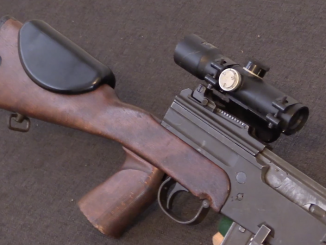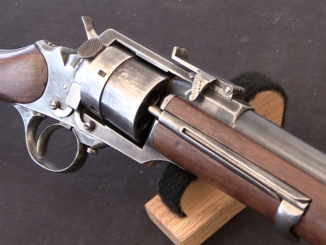When France decided to adopt a new 9x19mm submachine gun after World War Two, all three of the main French arsenals (St Etienne/MAS, Chatellerault/MAC, and Tulle/MAT) developed designs to compete for adoption. Tulle would eventually win and their design became the MAT-49, but the other lines of development are quite interesting.
The MAS design from 1948 was a lever-delayed system, anticipating perhaps the later FAMAS rifle. We have a series of developmental prototypes to look at today, from early prototypes to an example used in field trials in Indochina. They all share the same basic mechanical system, but cary in many details including stock design and barrel length. Overall the design is pretty good, and they performed will in trials – but the lever-delayed action was much more complex and expensive to produce than MAT’s simple blowback design.
Many thanks to the IRCGN (Institut de Recherche Criminelle de la Gendarmerie Nationale) for allowing me access to film this series of prototype for you!




Would be interesting if you’d follow up w/ a video on the Savage A-17/A-22 lever delayed blowbacks. I realize it’s hardly a forgotten weapon, but lever delayed blowback is a difficult (difficile, even) concept for me at least to wrap my head around, and seeing it in a current weapon might help folks appreciate the FAMAS and this interesting subgun more.
unfortunately lever/roller/radial (they work with the same principle) delayed blowback is often atrociously explained. IE, if the explanation contains a “the bolt face can’t start moving until…” then it’s WRONG.
Let’s start without any bolt and any delay. The cartridge is fired, and the case is propelled rearward by the same pressure into it. The force that pushes the case rearward is proportional to the pressure inside it multiplied for the internal base area of the case. The higher the pressure, the larger the internal base surface of the cartridge, the strongest the force. If nothing stops, or delay, the rearward motion, before the bullet exits the barrel, the case is pushed out of the chamber enough to expose its thin walls that, at that point, no more supported by the chamber, are ruptured by the same internal pressure.
To avoid that, a simple way is to add mass (of the bolt) to the base of the cartridge (pure blowback action). If you double the mass, you halve the space the base of the cartridge, pushed by a given force, can travel backwards in a given time (the time the bullet takes to exit form the barrel and make the internal pressure drop to safe level). Let’s say that, to be safe, you have to add enough mass that, in that time, the cartridge can travel backwards only a couple mm. The higher the pressure, the larger the internal base area of the cartridge, the higher the mass required. It’s a simple linear relation. If you have double the pressure, you need double the mass of the bolt. if you have double the internal base area of the cartridge, you need double the mass of the bolt.
Let’s say that, to safely shoot a 5.56 NATO cartridge in a pure blowback action, you need a 1.2KG mass bolt.
At this point, separate your 1.2kg bolt in a 0.2kg bolt face, and a 1kg bolt carrier.
Put a lever between the two, with the fulcrum pointed to the receiver. The bolt face touches the lever at 1cm from the fulcrum (point of effort), and the bolt carrier touches the lever at 2cm from the fulcrum (point of load). https://static.wikia.nocookie.net/vietnamwar/images/b/b7/FAMAS_Bolt-gr.PNG
https://static.wikia.nocookie.net/guns/images/1/19/Lever-delayed-action-animation.gif/revision/latest?cb=20190312092230
What happens is that, for the bolt face (and so the case) to travel backwards for 2mm, the bolt carrier have to travel backwards 4mm, so it has to accelerate to double the speed in the same time.
And that requires double the force.
But the force is a given (pressure for base area)
So, to have the case, and the bolt face, to travel backwards for 2mm in the given time, you can halve the mass of the bolt carrier. 0.5kg instead of 1kg. so the entire bolt assembly, face and carrier (not counting the lever to make it simpler) will weight 0.7kg instead of 1.2kg.
if you can triple the speed of the bolt carrier in respect of the bolt face, you’ll need only 0.33 kg bolt carrier.
And so on.
You are exchanging mass of the bolt, with speed of a part of it.
There are other factors that should be taken into account (IE the same lever absorbs part of the force, since the fulcrum pushes against the receiver) but, broadly, that’s how it works.
Delayed blowback is a decent concept, but I’ll be damned if I see a need for it to be applied to a 9mm Parabellum submachinegun…
I think we can see why the MAT-49 was the final selected weapon. Simplicity; there’s no need for a locked breach 9mm unless you’re also suppressing it and/or need that added bit of accuracy from firing from a closed bolt.
I think it’d be possible and valuable to do up a chart of cartridge pressure/energy curves, showing what locking mechanisms are necessary and what works best in that cartridge’s envelope. I’d about guarantee you that none of the delayed-blowback systems do really well in the realm inhabited by the 5.56mm, requiring way too much tuning and cartridge consistency to work well. 5.56mm NATO is just too marginal, all the way around… You either get it just right, and it works wonderfully well, or you make a minor change or error that slips it right out of “working” and into “problematic”. That’s both mechanical and ballistic; the lack of lethal effect downrange with the M855 out of the M4 carbine is a perfect example, as is all the trouble the Spaniards had making the CETME 5.56mm products affordable to manufacture.
“(…)none of the delayed-blowback systems do really well in the realm inhabited by the 5.56mm(…)”
If it is so, then why HK 53 according to http://modernfirearms.net/en/assault-rifles/germany-assault-rifles/hk-hk33-i-hk53-eng/
…was developed in the mid 1970’s and is still in production and offered for export.
?
HK is the only company that’s managed to make roller-delayed blowback work in 5.56mm, and you’ll note that they didn’t try to keep the system going with the HK416 family…
Absent copious factory support from HK, the roller-delay systems don’t seem to be affordable to produce; from what I’ve been told, the Turks basically gave up on the idea after HK withdrew support, and it was because the reject rate on assemblies was unaffordable. Similar to the CETME Modelo “L”…
Also, the attempts by SIG and Beretta to get their roller-delay systems working in the 1960s led them to saying “The hell with this…” and both of them moving towards something a lot more AK-esque than anything else.
I’ll stick to my guns, thank you very much. 5.56mm works reasonably well in most rotary-bolt gas-operated systems designed around it. The recoil-operated attempts have all foundered on that whole issue of affordable manufacture due to the need for close precision and consistency.
Some cartridges just don’t work well with some systems, and that’s all there is to it.
“(…)they didn’t try to keep the system going with the HK416(…)”
After around 40 years.
“(…)I’ll stick to my guns, thank you very much.(…)”
Do as you wish, but to my understanding Harrington & Richardson T223 which was spawned by HK33, was highly praised by its’ users in 1960s.
https://guns.fandom.com/wiki/Petter_Mle_1939 claims that
Pistolet Mitrailleur Modèle 1939…was revived post-war in the form of the MAS 48…
They share “L-shaped” bolt and wooden stock arranged so weapon could be made more compact. Former weighted 6.4 kg, latter 3.0 kg, despite 1st consumed smaller 7,65 mm French cartridge.
Who designed MAS Mle 1948 and why elected such heavy weapon (by 1948 sub-machine gun standards) as starting point? Also why he elected to use design of other manufacturer (Pistolet Mitrailleur Modèle 1939 was done SACM from Mulhouse)? Did MAS Mle 1948 spawned any patent, which could be used to link it to designer?
Among popular cartridges, 9mm specs ideally suit delayed blowback because all its common loads are so balanced. 5.56, as you noted, is too quirky; 10mm too variable, 7.62N too powerful, and anything below 9mm too weak.
In practice, though, I agree with you. Unless you require extreme lightness and compactness (i.e. not this), there’s really no need.
Both the H&K G3 battle rifle and the AA-52 GPMG work pretty well with delayed blowback in 7.62N.
I’m not that familiar with the AA-52. The G3 works extremely well, but is noticeably harder-kicking, despite being noticeably heavier, than all the popular locked-breech battle rifles.
User reports about the AA-52 are less than enthusiastic. It was gladly replaced with the MAG-58, maybe not with as much enthusiasm as I had when the M240 replaced the M60, but… Close.
Ian Hogg and John Weeks disagreed, stating that even in the original 7.5 x 54mm chambering, any belt of ammunition fired in the AAT-52 always included empties showing signs of premature opening, such as excessive sooting on the outside and case distortion. Their conclusion was “The AAT-52 works, but only just”.
Maybe it worked better with 7.62 x 51mm due to different powder burning curve, different peak pressure, or etc., but I wouldn’t bet on it.
clear ether
eon
Ian Hogg stated: “AAT-52, is perfectly satisfactory with French cartridges, but cartridges manufactured in other countries, to a slightly different specification, show evidences of bulging at the base after extraction”.
And that in a passage where he was saying that: “Delayed blowback guns are not really satisfactory at all, though the people who use them usually manage to convince themselves that they have a good weapon.”
He doesn’t seem like a fan of delayed blowback guns in general.
I suspect that, with “cartridges manufactured in other countries, to a slightly different specification” he could mean “.308 Win.” cartridges.
Mind also that the French used steel cased “7.62 NATO” ammos, and steel cased ammos tend to “stick” more to the chamber.
Having been in service for 70 years, and counting, and being still in service, in particular, in remote installations (aircrafts, turrets…) where the gunner can’t easily, or at all, clear jams, I tend to put the AA-52 in the “it works” category. Maybe not the best GPMG in the world, and sensible to change in specification of the cartridge like every delayed blowback, but working yes, and that the main reason it had been partially replaced starting from 2008 had been the closing of MAS in 2001. Much of the guns were old and not replaceable.
Did the AA-52 GPMG in first 7.5x54mm. and later 7.62x51mm, really work “pretty well?” If so, how do we define those terms?
As said, it had been in service for over 70 years, and counting, and it’s still used in remote installations where the gunner can’t easily, or at all, clear jams. It would have been replaced way before had it not worked at least “pretty well”.
I have a feeling this could have become a strong competitor to the HK MP5.
I understand that it was maybe not the best choice for the french army in the late 1940s or early 1950s but it is sad that they did not try to sell it to other costumers.
you can actually experience the delayed blowback mechanism by constructing a two dimensional mockup on a table. All it needs is a pen, a ruler, some books or boxes.